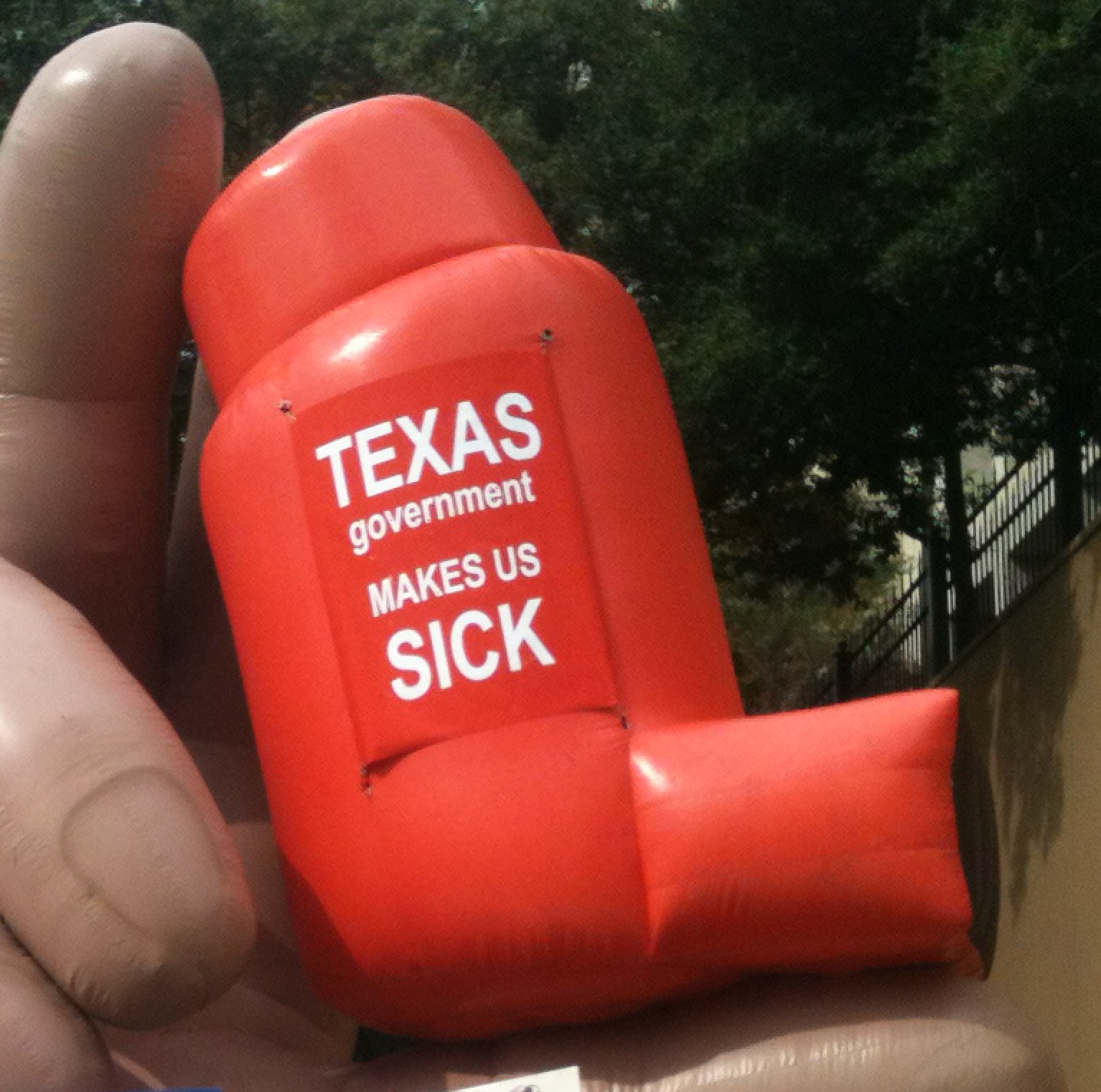Posts Tagged ‘DFW smog’
Chris Turner Becomes First State Representative to Ask EPA for new DFW Air Plan
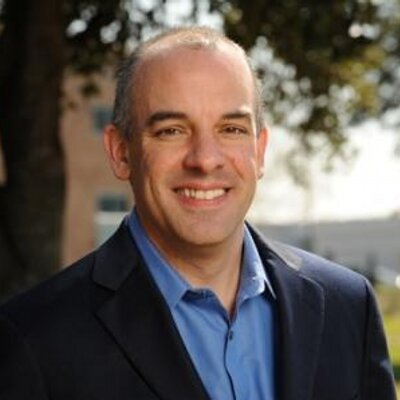 State Representative Chris Turner, whose District 101 spans west Grand Prairie and east Arlington between Dallas and Fort Worth became the first state elected official to urge EPA to reject the current state anti-smog plan for DFW and substitute one of its own.
State Representative Chris Turner, whose District 101 spans west Grand Prairie and east Arlington between Dallas and Fort Worth became the first state elected official to urge EPA to reject the current state anti-smog plan for DFW and substitute one of its own.
In a letter to EPA Chief Gina McCarthy, Turner used language echoing the sentiments of US Congresswoman Eddie Bernice Johnson and Congressman Marc Veasey.
"While I hope that the TCEQ will take the public comments it received by EPA, the Texas Medical Association, and others into consideration and require additional emissions controls in the final SIP revision it submits to EPA, I ask you to consider rejecting the state's plan use of a Federal Implementation Plan if your agency decides that the final SIP revision is insufficient and the state will not negotiate in good faith."
The entire letter can be read here.
Besides Johnson and Veasey's letters, Dallas County and the City of Dallas have voted in favor of resolutions condemning the currently proposed plan has being inadequate. More cities and counties are expected to pass similar resolutions as elected bodies come back from summer breaks.
Members of the DFW Clean Air Network (DFW CAN) – Downwinders at Risk, the Sierra Club, Beyond Coal, the Texas Campaign for the Environment, Mansfield Gas Well Awareness and Livable Arlington – are also out and about obtaining letters like Turner's from other state and federal elected officials.
Turner's district is directly downwind of the Midlothian cement plants and includes numerous natural gas wells and facilities. Gas sources are now the fourth largest contributor to DFW smog.
According to EPA, the state plan arrived at the EPA's doorstep August 8th, but it's already DOA.
Although ozone season is far from over and it's been a relatively mild "season" so far, we know in its second full year out of the three years allotted for success, the state air plan will, at best, have brought down ozone levels by 1 ppb from 2015 levels, to 80 ppb. We're supposed to be at 75.
The parrot is dead. We're just waiting for the state to admit it – or the EPA to shut the farce down.
Meanwhile, the more political support on the ground in DFW for an EPA alternative that might actually reduce emissions from major sources in North Texas like gas, cement kilns, and coal plants, the more likely it is for the Agency to accept the challenge, and endure all the pushback from Austin it'll get if it decides to take over the job.
If you're interested in trying to get your city, county, or state or federal elected officials to join the band wagon and reject the state plan, write or call us and we'll work with you in getting something accomplished that can add to the momentum.
We Have A Fight On Our Hands: Luminant Said To Be Trying to Scuttle Dallas Clean Air Resolution With Dallas Chamber Help
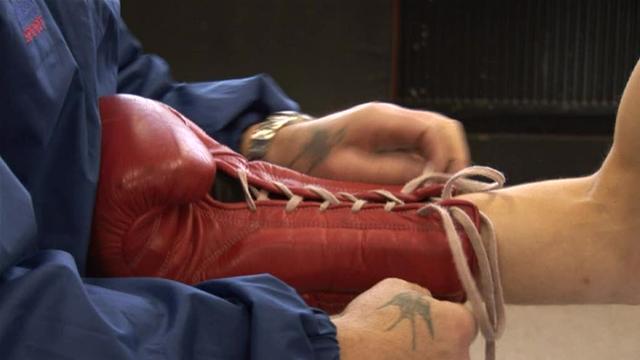 Only 48 hours after the single worst day for DFW smog since 2013, coal plant operator Luminant reportedly began a lobbying campaign to scuttle Sandy Greyson's Dallas city council clean air resolution requesting a better anti-smog plan.
Only 48 hours after the single worst day for DFW smog since 2013, coal plant operator Luminant reportedly began a lobbying campaign to scuttle Sandy Greyson's Dallas city council clean air resolution requesting a better anti-smog plan.
As a result, Item #12 “A resolution authorizing the City of Dallas to communicate its positions and requests regarding the Texas Commission on Environmental Quality's (TCEQ's) proposed State Implementation Plan for the Dallas-Fort Worth Region ozone pollution to the State of Texas, the TCEQ, and other agencies” is expected to be pulled from Wednesday’s unanimous voice-vote “consent agenda” and placed in line with other items generating discussion and dissent. It may be a long day – and that's exactly what the resolution opponents want in order to wear us down.
Luminant was said to be contacting city council members over the weekend, reportedly with the assistance of representatives of the Dallas Chamber of Commerce. In the past the company has stated it objects to the costs of installing the kind of modern anti-smog controls, referenced by the city’s resolution, at its three aging East Texas coal plants, despite their large smog-causing emissions. We don't know how successful the company's lobbying has been, or how much trouble the resolution is in.
If you're mad about this news, good. Here's what we need you to do:
1. If you haven't already, please follow this link and send a "click and send" ready-to-go email to all 15 Dallas city council members urging them to vote for the clean air resolution. You can add your own language at the bottom if you want.
2. Please sign up to speak in favor of clean air and the resolution on Wednesday
You must call the City Secretary''s office at 214-670-3738 to reserve a 3 minute speaking slot. Make sure you sign up for Item #12 on the consent agenda. If you don't sign-up in advance, you won't get to speak up on Wednesday!
We need to be there beginning at 9am, but we don't know how soon the resolution will come up in the agenda now. We know this makes it inconvenient. Again – not by accident. We've outlasted them before. We need to do it again.
3. Emphasize these Talking Points in your emails and speaking on Wednesday
-
All the air pollution control measures referenced in the city's clean air resolution are currently available, off-the-shelf technology, already in use in the world, US, and even Texas. Nothing exotic. Nothing experimental. There are coal plants and cement kilns with catalytic converters. There are already electric compressors. The resolution says only that the state should consider applying these technologies uniformly – to ALL major industrial sources affecting DFW air quality.
-
All the air pollution measures referenced in the city's clean air resolution are among the most cost-effective that can be taken, costing a small fraction of other measures already adopted. Putting controls on the coal plans and kilns costs $2-3,000 per ton of smog-forming pollution removed vs state programs spending $10-13,000 per ton. It's cheaper to prevent pollution at a dozen or so smokestacks than millions of tailipipes.
-
Most smaller Dallas businesses are already heavily-regulated for emissions because they're located within the DFW "non-attainment area," for smog, while the East Texas coal plants creating a huge chunk of that smog continue to be exempt from the same kind of regulations because they're located 90-100 miles outside the non-attainment area. They have more impact, but less regulation. That's not fair to Dallas-based businesses, or DFW''s seven million residents. We need small business owners to say the Chamber and Luminant doesn't speak for all of the Dallas business community.
-
The costs of installing new controls are small compared to the economic and public health costs of not installing them. Dr. Robert Haley's recent study for the Dallas County Medical Society concluded a drop of just 5 ppb in North Texas smog levels could save $650,000,000 in lost economic growth, and prevent hundreds of ER admissions, and 100 premature deaths – EVERY YEAR.
-
Luminant is taking the position that their three old coal plants are more important than the health of 1.2 million Dallas residents, and the other 5.5 million DFW citizens who breathe dirty air. The company is asking the Dallas City Council to place its interests above everyone else's.
-
DFW has been in continual violation of the Clean Air Act for smog since 1991. Our childhood asthma rates are higher than the state OR national average. EPA has already said the current plan doesn't do enough to lower smog levels to meet the federal standard. But opponents of the resolution have no alternative. They want the City of Dallas to sit on its hands and do nothing about 25 years of chronic smog – no matter how many people are affected by bad air. Does the City of Dallas really want to send the message that it doesn't care about clean air only a week before it hosts its own "Clean AIr Action Day" event at City Hall Plaza next Friday?
Some critics of these resolutions have argued they're only symbolic requests for cleaner air, and don't mean that much, or carry that much weight. If Luminant's reported response is any indication, it thinks this resolution is a threat to plans to sell-off those aging coal plants as part of its parent company's bankruptcy. We must be doing something right to engender this kind of alleged opposition from North Texas' King of Coal.
DON'T LET BIG COAL WIN THIS FIGHT
SPEAK UP IN SUPPORT OF CLEAN AIR – Call the City Secretary and Register to speak on Wednesday
THIS WEDNESDAY, JUNE 15th
9 AM DALLAS CITY HALL 1500 MARILLA
Summer Isn’t Coming, It’s Here. Ozone Season Arrives with a Vengeance.
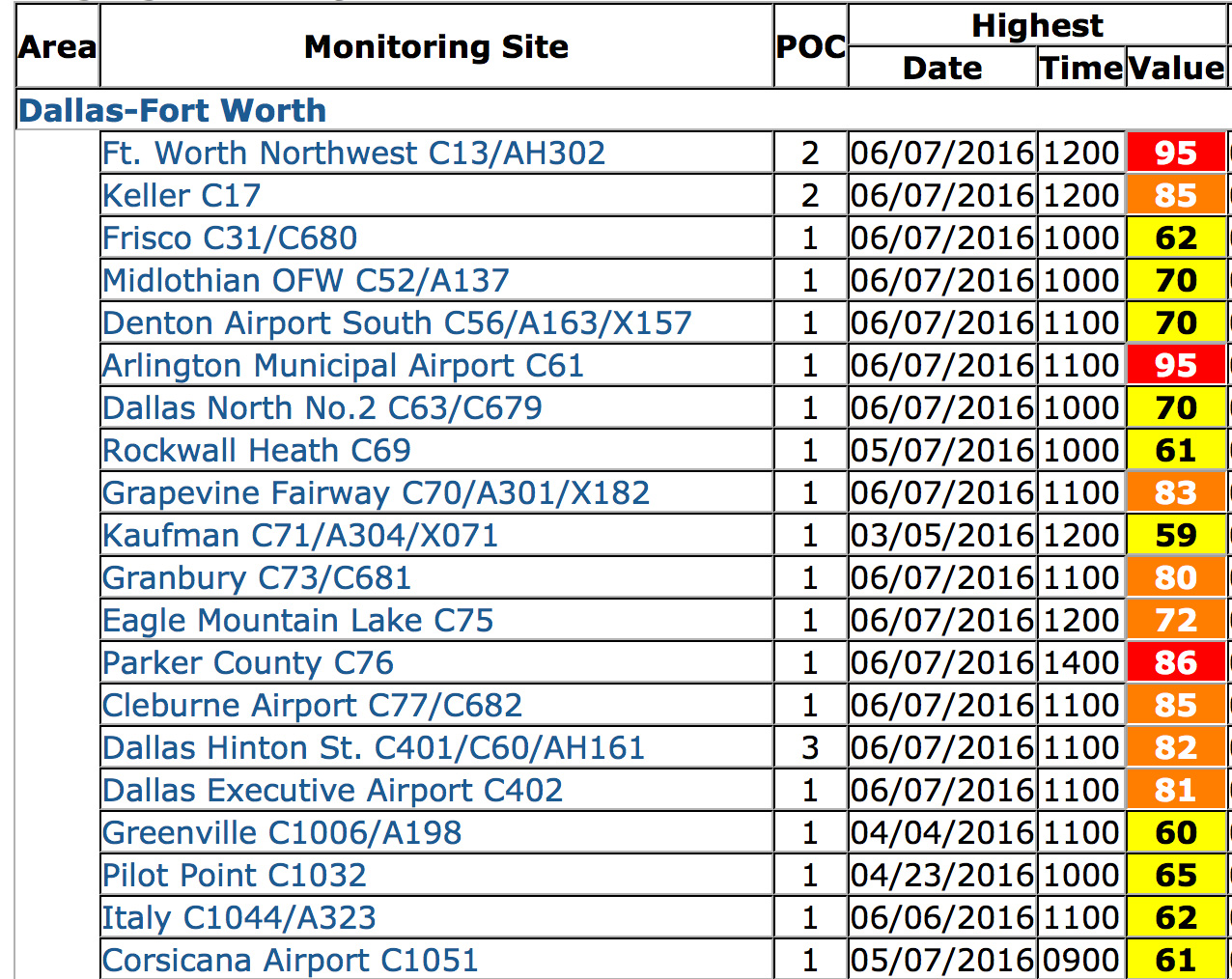 Yesterday was the single worst day for DFW smog in the last three years.
Yesterday was the single worst day for DFW smog in the last three years.
Seven monitoring sites stretching from central Dallas to Weatherford saw hourly averages of 90+ parts per billion. Three sites in Arlington, Northwest Fort Worth and Keller saw levels reach 100 + ppb. Two of those sites saw hourly levels climb to 113 ppb. To give you some idea of how bad that is, the original dreadful, obsolete standard during the 1980's and early 90's was 125 ppb in a single hour. We probably came within an hour or two of reaching a level of air pollution at not one, but two sites yesterday that would have exceeded a 40-year old smog standard.
14 out of the 20 DFW monitors recorded average ozone "exceedences" that violated the current 75 ppb 8-hour standard (what you see above). Two sites saw 8-hour averages of 95 ppb, the worst showing since September 2013.
It became a hazard to breathe for hundreds of thousands, maybe millions of DFW residents, yesterday afternoon. South Arlington residents experienced unhealthy levels of air pollution from 12 noon to 7 pm. In Keller it was 2 to 7 pm.
The good news? It could have been worse. The only thing preventing even higher numbers was the changing wind direction in mid-day. Monitors located in Dallas were recording high smog levels in the morning and lunchtime from northerly winds, but then they turned east and the pollution headed west, raising smog levels across broad swaths of Tarrant, Johnson, and Parker Counties. Had the wind been coming from the east all day, you would have seen the numbers those monitors reached at 2 -5 pm happen sooner, with more room to grow.
Wednesday also looks to be a bad day, as does the rest of the week of full-bore summer sunshine. Bad as they were, none of yesterday's exceedences actually count as a Clean Air Act violation…yet. It takes four bad days where the 8-hour average exceeds the 75 ppb standard over the course of the ozone season to make a violation. Regulators only use the fourth highest smog level recorded at each site to determine the annual average and whether an area is meeting the Clean Air Act standard (you can keep track of those here). Yesterday, nine monitors recorded their first exeedence of the year. Only three more to go.
However, the region's current reigning bad air champ, the Denton airport monitor, uncharacteristically remained out of harm's way and saw levels barely above the 75 ppb standard in mid-afternoon. It'll have it's chance. Summer is only beginning.
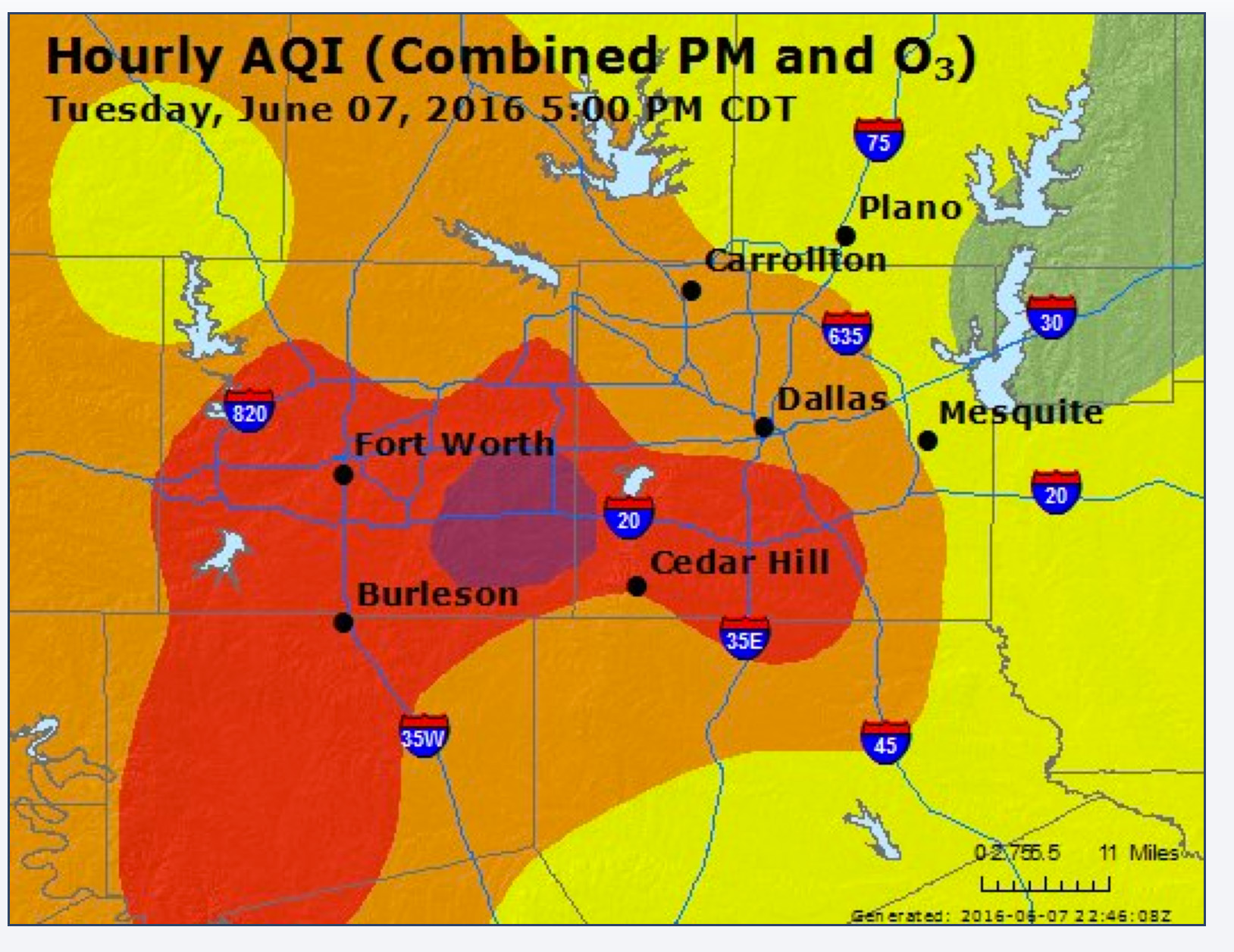 Tuesday's smog attack put an exclamation point in front of next Wednesday's Dallas City Council scheduled vote on Councilwoman Sandy Greyson's air quality resolution rejecting the current state plan – ain't it working out swell!? – in favor of a plan to eliminate days like yesterday.
Tuesday's smog attack put an exclamation point in front of next Wednesday's Dallas City Council scheduled vote on Councilwoman Sandy Greyson's air quality resolution rejecting the current state plan – ain't it working out swell!? – in favor of a plan to eliminate days like yesterday.
Greyson's resolution requesting a new and better clean air plan, as well as the staff presentation that provided background information, can be reviewed here. It's similar in content to one passed earlier in May by Dallas County.
Supporters can sign-up to speak for 3 minutes each when it comes up on the agenda and as always, we'll have plenty of lapel pins with the DFW Clean Air Network logo on them so you can non-verbally support the resolution as well.
If you want to speak at the Council meeting in favor of clean air, please contact the City Secretary beginning at 8:15 am tomorrow, Thursday, June 9th at (214) 670-3738 to reserve a 3-minute speaking slot or Item #12 on the "consent agenda."
Consent agendas are tricky things. They require complete unanimity among all 15 council members and are usually reserved for the most benign, non-controversial subjects. So at first glance, it's a good thing our resolution is on the list because it implies support from all 15 members.
But, and it's a big but….any member who doesn't agree it should be on the consent agenda can ask that it be taken off and placed in the "Items for Individual Consideration" bin – kind of like going to the back of the line and waiting for all the other business to get done before re-visiting the matter.
If there's industry opposition, or any opposition for that matter, it would give a council member an excuse to take it off the consent agenda and send it to the back of the line in hopes us cooling our heels and losing speakers as the day wears on. And it only takes one council member disagreeing to do so. This is why we need you to send emails to ALL 15 council members.
Since it's on the consent agenda, at least for now, it'll be among the first orders of business next Wednesday. Supporters need to show up at 9 am sharp.
Dallas passing this resolution would mean that the most populous city in the DFW "non-attainment area" for smog is rejecting the anti-science "do-nothing" approach of the State and demanding a better strategy to actually clean up chronic air pollution.
That's exactly the kind of statement local governments have to send EPA in order for the federal agency to screw-up enough courage and reject the current state proposal in favor of something better.
And after yesterday, is there anyone outside of Austin who believes we don't need something better?
Dallas City Council Clean Air Vote
Wed. June 15th 9am
Dallas City Hall 1500 Marilla
Dallas Council Committee Votes for Air Quality Resolution, Heads for Full Council Vote in June
SEND A "CLICK N SEND" EMAIL TO ALL 15 DALLAS CITY COUNCIL MEMBERS URGING THEM TO VOTE FOR CLEANER AIR IN JUNE
By a vote of 5 to 1 the City of Dallas moved closer to joining Dallas County in repudiating the State's do-nothing DFW clean air plan and demanding something better.
It was the second vote in less than a month to condemn an anti-smog strategy the Texas Commission on Environmental Quality claims gets DFW "close enough" to the current federal standard, but is criticized by clean air advocates as inadequate to end the region's chronic bad air problem.
In April U.S. Congressional Representatives Eddie Bernice Johnson and Marc Veasey asked the EPA to reject the State plan and write its own.
Council members Mark Clayton, Philip Kingston, Tiffini Young, and Rickey Callahan backed a wide-ranging air quality resolution sponsored by Quality of Life Committee Chair Sandy Greyson. Casting the lone no vote was Adam McGough.
Greyson's resolution cites the EPA's conclusion "that the latest air quality State Implementation Plan (SIP) proposed by the Texas Commission on Environmental Quality (TCEQ) is not adequate to address the (the region's) ozone concentrations"
One reason given for the inadequacy is the plan doesn't touch major sources of air pollution affecting DFW including the East Texas coal plants, the Midlothian cement kilns and oil and gas facilities. The resolution specifically requests the state to follow the prescription laid out by UNT's landmark 2015 DFW ozone study, itself based on the State's own computer air model by adding off-the shelf control technology to those industrial sources.
Besides rejecting the state's plan, the resolution also takes issue with the State's assertion that lowering smog levels won't improve public health by specifically adding a provision stating "…studies have shown a direct correlation between health issues, such as asthma and chronic obstructive pulmonary disease, and higher levels of ozone…"
It also calls for more renewable energy, net metering and an endorsement of the Obama Administration's Clean Power Plan – a 2016 Dallas Omnibus Air Quality resolution.
Nobody had anything nice to say about the Texas Commission on Environmental Quality, and Councilman Philip Kingston was particularly pointed in his criticisms. During a discussion about Dallas taking on some of TCEQ's enforcement duties, Kingston explained why the City preferred to to it themselves, rather than leave it up to the State: "Because they do the same thing with that responsibility as they do with all their responsibilities – they ignore them." Amen.
The resolution now goes to the full Dallas City Council for a final vote at one of two meetings before the summer break – either June 15th or June 22nd. Stay tuned for details.
Meanwhile, RIGHT NOW – you can send a quick e-mail toall 15 Dallas City Council members asking them to vote for the Greyson air quality resolution when it shows up on their doorstep. You can add a message of your own if you want.
Join Us for the First DFW Air Quality Vote of 2016
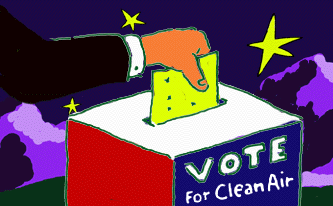 Dallas County Commissioners' vote on sending state air plan back to Austin:
Dallas County Commissioners' vote on sending state air plan back to Austin:
This Tuesday, May 3rd, 9 am 411 Elm Downtown Dallas
First air quality vote of 2016
Come help us thank local officials for standing up to the state
This next Tuesday, May 3rd, the Dallas County Commissioners Court will hold an historic vote.
Commissioners will be asked to go on record as the first local North Texas government urging the EPA to reject the currently proposed state air plan for DFW and replace it with a stronger one that actually cuts pollution.
Pct. 1 Commissioner Theresa Daniel is sponsoring a resolution that requests EPA to do two things:
"…to reject the proposed State Implementation Plan for DFW ozone pollution, and require a new federal DFW clean air plan that can meet or exceed the current 75 ppb federal ozone standard at all North Texas monitoring sites, and implement all reasonably available pollution controls as defined by the federal Clean Air Act.
and
"...regulate East Texas coal plants as if they were in the DFW non-attainment area, or include them in a larger non-attainment area for North Texas under rules governing the new federal 70 ppb ozone standard."
As the most populous county in the 10-County DFW "non-attainment area" for smog, Dallas carries a lot of political weight. Passing such a resolution would be an important signal to other local officials concerned about the two-decade plus chronic air pollution problem in the region.
Downwinders and other citizens groups have formed a new ad-hoc alliance to campaign for similar resolutions in other North Texas cities and counties as part of a broader effort of convincing EPA to replace another state "do-nothing" air plan with one of its own.
The DFW Clean Air Network, or DFW CAN, includes the Dallas Sierra Club, and the Sierra Club's Beyond Coal campaign,Public Citizen Texas, Mansfield Gas Well Awareness, Liveable Arlington, and Texas Campaign for the Environment.
It's important to recognize what a challenge Commissioner Daniel and others are facing in taking on Austin over this issue. They need to see your support for their brave stands. And all the Dallas County Commissioners need to be reminded how long we've had to breathe dirty air and why we're fed-up with the state's apathy.
We CAN win this vote.
We CAN make a difference.
We CAN breathe clean air.
Morning News Names Jeff Mosier as its New Environmental Reporter
 Notice came on Friday that the Dallas Morning News had finally decided to fill the environmental beat reporter position left vacant by Randy Lee Loftis' departure. The lucky winner was announced via a response to a reader's comment on a story about the Lake Lewisville BLM fracking lease sale.
Notice came on Friday that the Dallas Morning News had finally decided to fill the environmental beat reporter position left vacant by Randy Lee Loftis' departure. The lucky winner was announced via a response to a reader's comment on a story about the Lake Lewisville BLM fracking lease sale.
"This is just one more reason the Morning News needs an environmental beat reporter," wrote the reader.
"That would be me," replied reporter Jeff Mosier, whose debut under his new job title was that day's story on the BLM fracking lease.
Shortly after, Mosier sent out this "job status" tweet with picture of the Lake Lewisville story, "My debut as environmental writer for @dallasnews. I'll spend more time at landfills than Super Bowls now"
That's a reference to Mosier's stint as a DMN SportsDay reporter covering the Cowboys on and off since at least 2004. Texas environmental politics is definitely a contact sport, but that's not the reason he was picked. He's a News journeyman who came to the paper with a lot of other former Times Herald employees in 1994 and rose through the ranks on a number of different beats. Here's a sampling of his coverage of Dallas City Hall goings-on. So local politics is not a foreign subject matter.
More on point, he was writing for the News' Tarrant County/Fort Worth Bureau in the early stages of the citizen backlash to urban drilling in the Barnett Shale. He's familiar with the issues surrounding fracking and wrote about them from roughly 2009 to 2013. Some examples:
Air tests at natural gas drilling sites fuel concerns in Barnett Shale
State will report today on Barnett Shale air pollutants
Texas House bill seeks to scale back city gas drilling restrictions
Arlington suing Chesapeake Exploration over claims of unpaid natural gas royalties
Cowboys Stadium site isn't expected to be used for gas drilling
From all previous indications, it looked like the News was grooming long-time Educational Reporter Jeffery Weiss to take Loftis' place. Weiss covered the unveiling of Downwinders' UNT Ozone Study and Dr. Robert Haley's Public Health Cost Study back in October, as well as the subsequent Dallas County Commissioners' resolution on reducing pollution from obsolete East Texas coal plants. But apparently Weiss is being put in charge of Energy coverage for the paper.
These moves are all part of a large shake-up of the entire Morning News newsroom as the paper tries to make the on-going rocky transition from print to digital. Lofttis' retirement could have been seen as a chance to do some necessary belt-tightening at the expense of a hunk of coverage. To the paper's credit, it resisted that temptation and named a new environmental beat reporter.
While Mosier's not a complete neophyte, he faces a steep learning curve. Give him some slack as he begins to reacquaint himself with The Way Things Really Work, and let's see if he can provide the public with needed clear-eyed reports from the front.
New Comments from EPA on DFW Air Plan: It Won’t Work
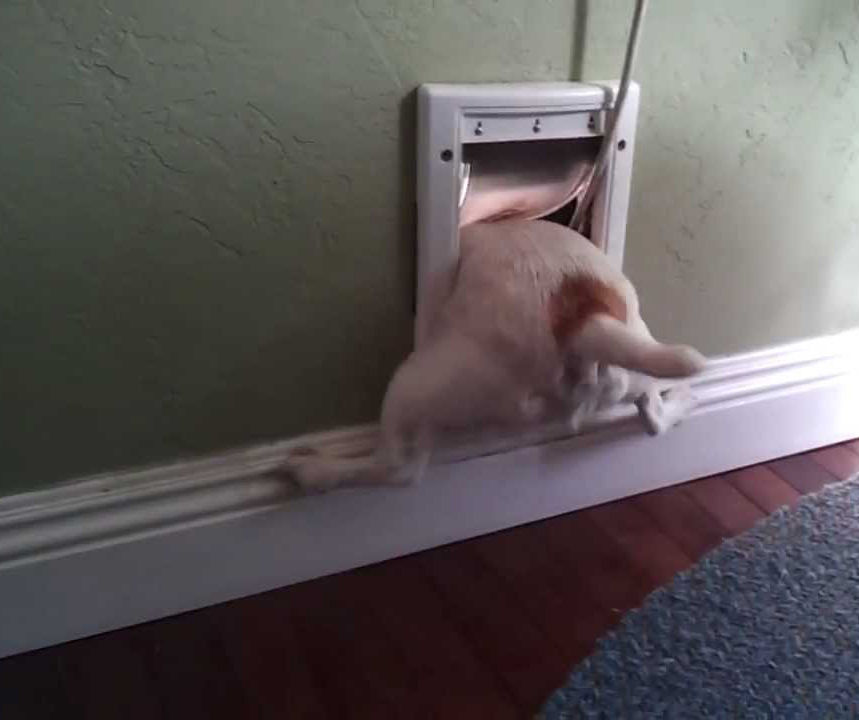 This plan won't work.
This plan won't work.
That's the simple message from the three pages of new comments Region 6 EPA staff submitted to the Texas Commission on Environmental Quality last month concerning its anti-smog plan for DFW.
That message begins with the cover letter, written by Mary Stanton, Chief of the State Implementation Plan Section for Region 6. "… additional local and regional ozone precursor emission reductions will be necessary to reach attainment by 2017."
How much in reductions? EPA estimates an additional 100-200 tons per day more in cuts of smog-forming pollution will be necessary to achieve compliance with the current 75 parts per billion ozone standard. "Without emission reductions on this scale, it is unlikely that the area will attain by the attainment date.”
To give you some idea of how large a number that is, TCEQ calculates that all gas and oil air pollution in DFW equals 78 tons per day, the Midlothian cement plants belch out over 18 tons per day, and all the power plants in the immediate DFW area, 21 tons per day. Totaled, those three sources add up to 117 tons of pollution a year.
All the cars and trucks on DFW roads are said to add up to 180 tons per day of pollution.
So the decrease in pollution EPA is saying is necessary to get down to the current ozone standard is huge.
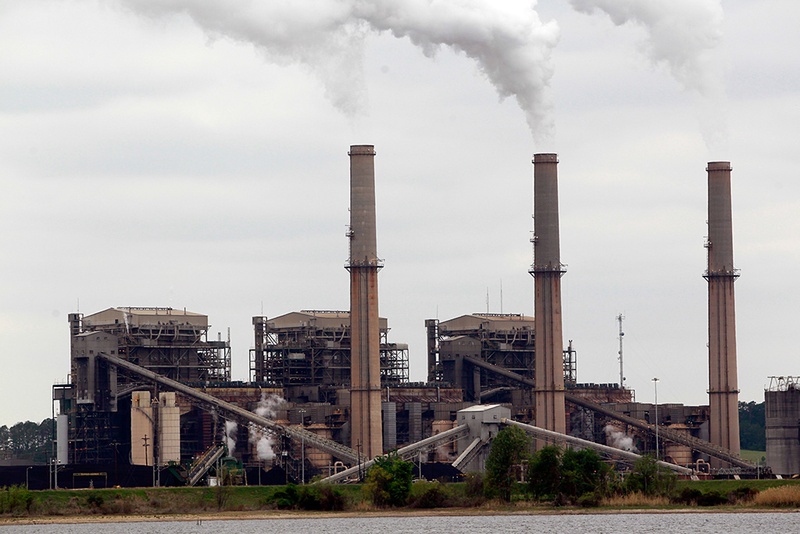
But take a look at those obsolete East Texas coal plants outside the boundaries the DFW nonattainment area. TCEQ says they account for a total of 146 tons per day. Add Selective Catalytic Reduction (SCR) which can get you up to 90% reductions in coal plant emissions, or close them down completely, add decreases from new controls on the cement kilns and oil and gas sources, and you're well on your way to amassing 200 tons a day of cuts in pollution.
Which do you think is more attractive to most DFW residents: permanently parking their cars, or putting new controls on the coal plants? Even though the coal plants harm the whole DFW airshed more than any other major source, they're not held accountable to the same regulatory requirements as sources closer to the center of the urban core, but which have less impact. Our cars must have special gasoline formulas in summer, we have to have HOV lanes, and we still go through Ozone Action Days, but the coal plants party like it's 1979. TCEQ is taking a hands-off approach to the plants and as a result the DFW region will continue to be in violation of the smog standard or huge cuts from other sources will be necessary.
TCEQ could have added new controls to the coal plants to the plan, but it chose not to. In fact, there are no new controls in the state's plan on any major sources of air pollution affecting DFW. EPA's new comments go to the heart of that choice. "Without additional emission reduction measures, we don’t see how the area will meet the standard of 75 ppb by the end of the 2017 ozone season," writes EPA staff.
EPA goes on to say TCEQ's computer modeling supporting it's do-nothing plan is "unrealistic," severely underestimating future smog levels, and delivering projections of decreases "that seem unlikely to be reached."
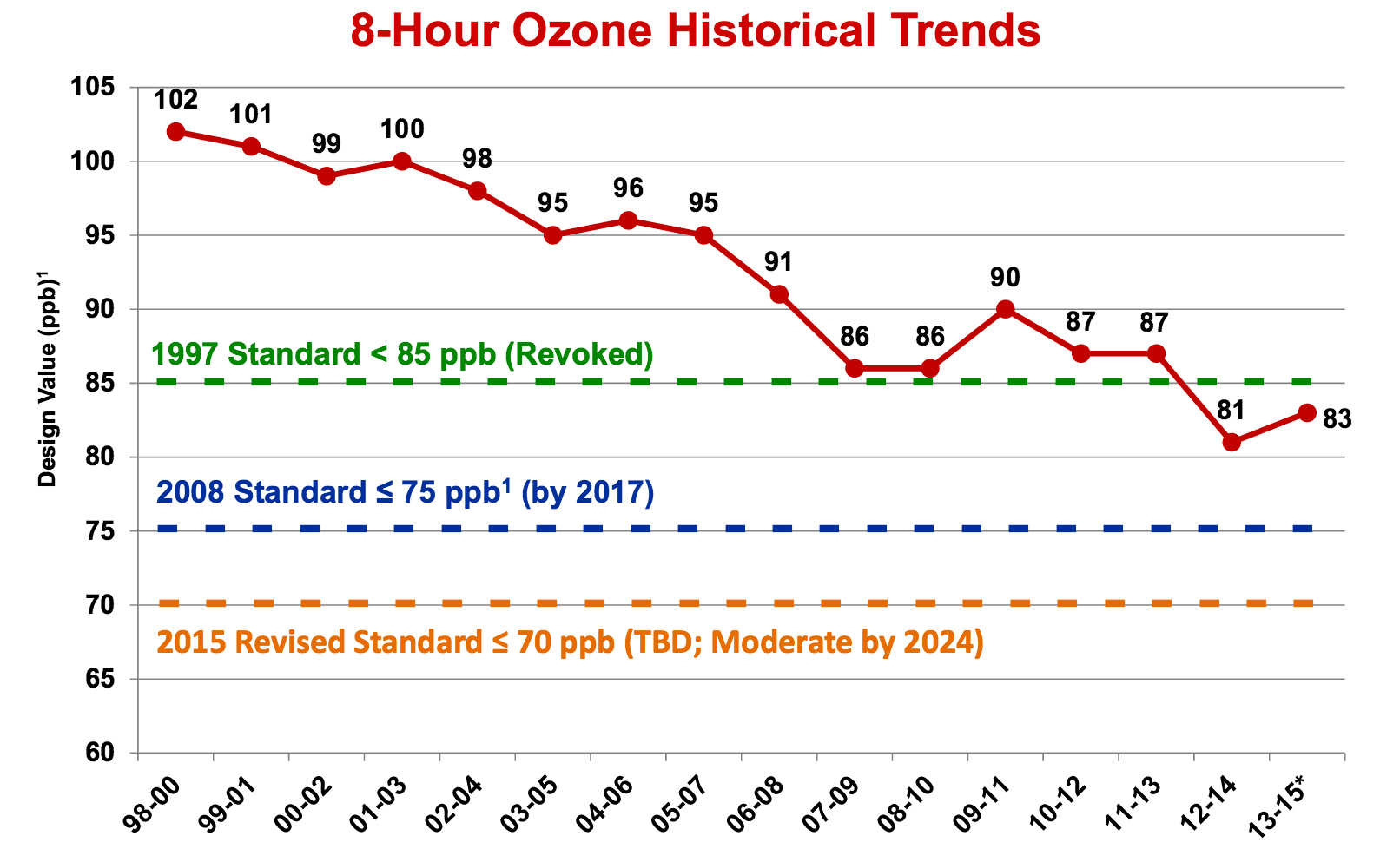 With this stance, EPA seems poised to reject this "attainment demonstration" part of the air plan as being insufficient. But it must wait to see how TCEQ responds to EPA comments about its modeling shortcomings and need for new cuts when the state officially submits its plan this July. Then, and ony then can the Agency approve or disapprove. We're going out on a limb here and predicting TCEQ won't change a thing, thus inviting EPA disapproval.
With this stance, EPA seems poised to reject this "attainment demonstration" part of the air plan as being insufficient. But it must wait to see how TCEQ responds to EPA comments about its modeling shortcomings and need for new cuts when the state officially submits its plan this July. Then, and ony then can the Agency approve or disapprove. We're going out on a limb here and predicting TCEQ won't change a thing, thus inviting EPA disapproval.
That's the pattern TCEQ has already established with its "screw you" response to the EPA's comments about the part of the plan dealing with "Reasonably Available Control Technology," or RACT, last February. This second part decides what new controls should be required of major sources of air pollution within the 10-County DFW "non-attainment" area – like the Midlothian cement plants and the thousands of oil and gas facilities checkerboarding the western half of the Metromess.
TCEQ says nothing new is required. EPA disagrees. EPA told TCEQ last year it had to do a new RACT review and lower the kiln's emission limits to account for a new generation of technology or it would have to reject the state's plan. TCEQ ignored the request, daring the EPA to disapprove. EPA seems more than willing to take them up on the offer.
And so while you're waiting for the state's computer modeling and suspect math to be rejected by EPA in July, you can probably expect to see EPA officially rejecting the RACT part of the state's plan sooner – maybe as soon as the next 60-90 days.
Despite the TCEQ going out of its way to submit an unacceptable plan to EPA, if the Agency pulls the trigger and begins a federal takeover of the DFW air plan, the Commission and the whole of Texas State Government will cry bloody murder about the usurpation of the state's authority and once again proclaim how "out of control" the EPA is on their way to filing suit.
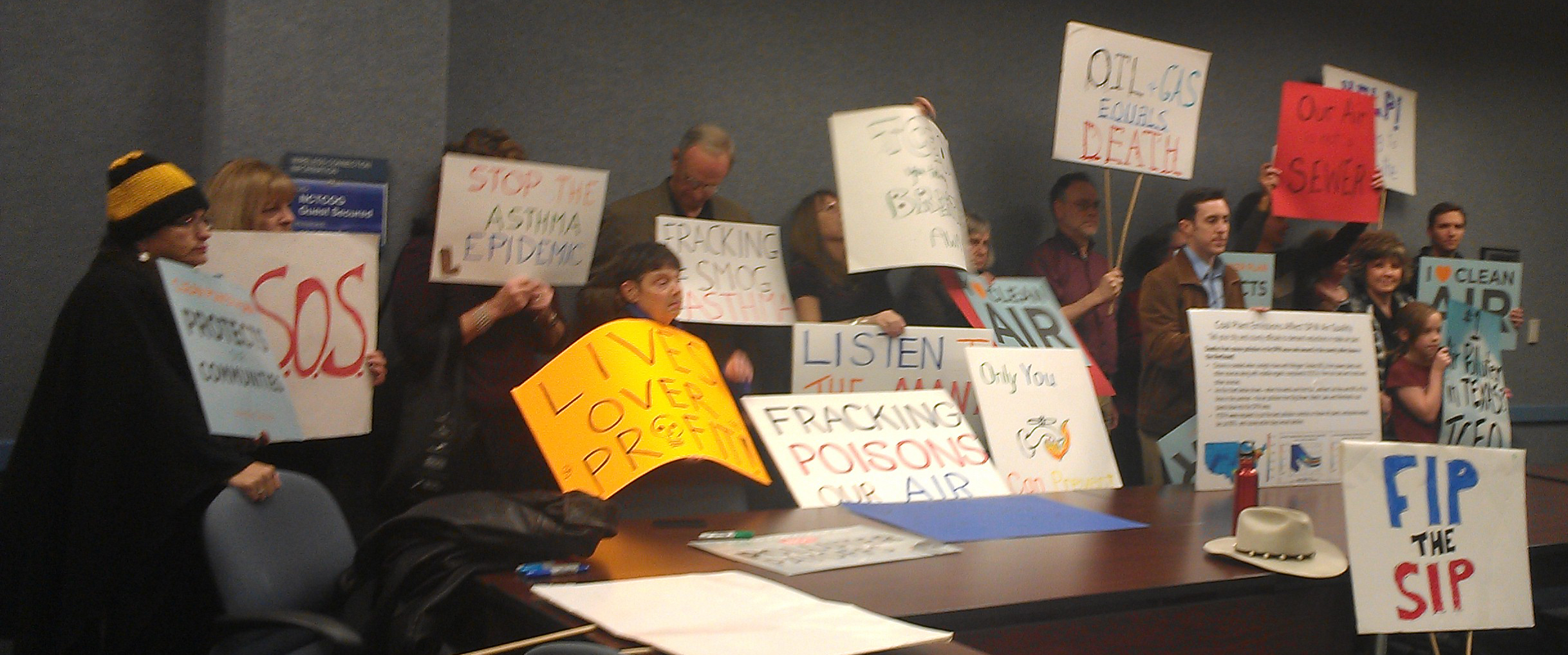 This is why the rowdy eruption of public sentiment for an EPA plan at the hearing in Arlington two weeks ago was so critical (Thank you again). It's also why we now have to be about the business of getting DFW local governments, hospitals and school districts to pass resolutions in favor of an EPA takeover. The Agency will need this kind of public support to counter all the criticism it will take from the Usual Suspects in Austin and DC. If you're interested in helping us pass one of these resolutions in your county, city, school or hospital district, please let us know at: downwindersatrisk@gmail.com
This is why the rowdy eruption of public sentiment for an EPA plan at the hearing in Arlington two weeks ago was so critical (Thank you again). It's also why we now have to be about the business of getting DFW local governments, hospitals and school districts to pass resolutions in favor of an EPA takeover. The Agency will need this kind of public support to counter all the criticism it will take from the Usual Suspects in Austin and DC. If you're interested in helping us pass one of these resolutions in your county, city, school or hospital district, please let us know at: downwindersatrisk@gmail.com
And as always, it's why you, and people you know should:
State Re-Submits Illegal DFW Smog Plan, Dares EPA to Reject It

(Dallas)– In an unprecedented rebuke to the Environmental Protection Agency, Texas has refused to provide critical data EPA says it needs to approve the state’s controversial anti-smog plan for DFW, which requires no new pollution controls despite more than two decades of chronic bad air.
Texas' refusal to cooperate with EPA puts its plan, scheduled to be approved by the Texas Commission on Environmental Quality December 9th, on a collision course with the federal agency.
Although EPA gives state governments authorization to write smog plans for their own metropolitan areas, it still has final approval based on criteria listed in the Clean Air Act. EPA disapproval of the State's DFW plan would trigger the possibility of a federal takeover of the air planning process.
That would be fine with local air quality activists, who've been pushing for the EPA to take over the job of writing a new clean air plan for North Texas since the State unveiled its first draft last year. They say TCEQ's official position that smog isn't harming public health means the Commission can't be trusted to write an effective anti-smog plan. When the state announced a plan imposing no new controls on any sources of air pollution despite DFW being in continual violation of the Clean Air Act for the last quarter century, they feel they were proven right.
"It's as if the state is too embarrassed to do what EPA is asking for fear of finding facts that don't match its ideology," said Jim Schermbeck, Director of the local clean air group, Downwinders at Risk.
He noted among the most important missing items in the State’s final plan published November 20th was a "Reasonably Available Control Technology"(RACT) study for the Midlothian cement plants, as well as answers to the impact of controls on other sources like the East Texas coal plants and oil and gas facilities that EPA posed in its eleven pages of official comments on the first draft last February. Application of modern pollution controls to all major sources of air pollution in a smog-plagued region is a key component of the Clean Air Act.
In official comments last February, EPA specifically requested the state perform a new study of what kind of smog controls should be required of the three Midlothian cement plants immediately south of DFW. EPA warned lack of such a study would mean the plan would be disapproved:
"Failure to conduct a thorough RACT analysis for cement kilns which would include appropriate emission limits would prevent us from approving the RACT portion of the attainment plan submittal.”
By turning-in the same version of the technology review originally criticized by EPA, without any new additional analysis, the TCEQ began a bureaucratic game of "Chicken," daring the EPA to deny approval.
"If you're EPA, I don't see how you take this any other way than a big raised middle finger from Austin," said Schermbeck. "The question is: What's EPA gonna do about it now?"
Also missing in the final state version are any responses to other EPA's concerns and questions about the plan's chances of actually lowering smog levels and the possibilities of reducing smog with new controls on other sources, such as,
“How would a reduction in NOx emissions from utility electric generators in the counties closest to the eastern and southern boundaries of the DFW area impact the DFW area?”
EPA was already openly skeptical about the chances of the state’s plan succeeding without requiring any additional cuts in pollution. Stating “it would be difficult to see” how the plan meets its required 2017 deadline, the Agency concluded “we believe it is likely that additional reductions will need to be included to demonstrate attainment.”
TCEQ’s resubmitted plan doesn’t have any additional reductions. Failure of a state plan to show how it can reach the smog standard by 2017 would be cause for EPA to assume the job itself.
Evidence suggests the state is purposely overlooking the air quality benefits of controls on large industrial sources of air pollution affecting DFW.
In late October, Downwinders at Risk released a new study of its own. It paid for University of North Texas engineers to build a clone of the State’s DFW air computer model and run a series of control scenarios the state hasn’t performed in almost a decade. Using the TCEQ’s own numbers it showed new controls on the cement kilns, coal plants, and gas compressors in the Barnett Shale would lower smog levels enough to meet the current federal smog standard. DFW hasn’t met a federal standard for smog since once was created in 1991.
Dismissing the results as “limited,” TCEQ officials nevertheless agreed with them – since they were based on their own model. The State argues those new controls are not yet technically or economically feasible – despite their being commonplace around the world, in the US, and even in Texas.
This question is one of the keys to the standoff with EPA: are the proposed new controls for industry “Reasonably Available” or not? If they are, they must be included in the air plan. If not, they remain off the table. EPA makes the first call on a definition, and any aggrieved party can sue to expand or contract it.
Because it’s a national hot spot for smog, DFW is only one of a handful of US metro areas that even had to submit a clean air plan this last cycle. EPA computer modeling predicts the area will still be in violation of the Clean Air Act in 2015 unless significant reductions in pollution are made.
This summer saw the North Texas regional smog average rise twice in one hot August week, retreating from gains made during last year’s cooler, wetter summer. DFW once again has higher annual smog levels than Houston. Both cities remain well above the current standard.
According to the American Lung Association, the 10 county DFW “non-attainment” area for smog includes approximately 150,000 asthmatic children, 350,000 adults with asthma, and over 600,000 adults with cardiovascular disease or COPD – all of whom are at risk from the region’s bad air.
“The lungs and lives of seven million residents are being held hostage by a state government that doesn’t think smog is a problem and isn’t willing to require new pollution controls to reduce it, “ Schermbeck pleaded
“Expecting the State of Texas to enforce Environmental laws in 2015 is like expecting the State of Mississippi to enforce Civil Rights laws in 1965. Our only hope is federal intervention.”
DFW One of Only Ten Areas Nationwide Not Expected to Meet New Smog Standard by 2025
 There was a lot of coverage of last week's announcment of a new, more protective national smog standard by EPA. Most of it centered on the reaction by both sides that it was either not enough progress (public health advocates), or Western Civilization was about to collapse under the weight of all the controls necessary to meet the standard (National Chamber of Commerce, et al.).
There was a lot of coverage of last week's announcment of a new, more protective national smog standard by EPA. Most of it centered on the reaction by both sides that it was either not enough progress (public health advocates), or Western Civilization was about to collapse under the weight of all the controls necessary to meet the standard (National Chamber of Commerce, et al.).
But if you read deeper into the articles, many of them mentioned computer modeling EPA had already done that demonstrated, given current trends, only 14 counties, representing 10 separate areas, wouldn't be able to meet the new standard by the target year of 2025. Unfortutantely, none of those articles mentioned which 14 counties, or which 10 areas.
Now, given all that you already know about our state and regional track record for meeting clean air deadlines, your first question might be: how many of those are in Texas? We'll give you a minute or two to start a pool and pick a number….
And the answer is: Three. Brazoria and Harris Counties in the Houston "non-attainment area" for smog, and Tarrant in DFW's non-attainment area. (The ten areas are: Baltimore, Dallas-Fort Worth, Denver, Fort Collins, Houston, Louisville, Milwaukee, New Haven, New York, and Pittsburgh).
Of course, for the purposes of regional smog record-keeping, EPA doesn't separate Tarrant County numbers from Dallas County, or Denton County, or any of the other nine counties in the non-attainment area. If one monitor is out of compliance in the area, the whole region is considered in violation. So EPA is conceeding that both DFW and Houston will still continue to be in continual violation of the Clean Air Act for another decade.
This is discouraging but not surprising. The State refuses to put new-generation controls on large major polluters like the Midlothian cement plants, East Texas coal plants, and gas production facilities, while painting the rosiest scenarios with its own modeling.
But this new revelation means it's that much more important to get EPA to override the state and act now to include controls on those major polluters, while the current smog plan is in the pipeline. It may be the only chance we have in the next 5-10 years to adequately address these sources. This can only be done if the EPA decides to revoke Texas' authority to write and implement these plans – to commit to a Federal Implementation Plan of its own.
PLEASE….
1) Sign our Change.Org petition urging the EPA to reject the state's clean air plan for DFW and substitute one of its own, and
2) Send an e-mail to the Chief EPA administrator in Washington and the Regional Administrator here in Dallas saying you want them to take responsibility for a new DFW air plan.
Thanks.
Going Backwards: DFW’s Annual Smog Average Went Up Twice in Two Days Last Week
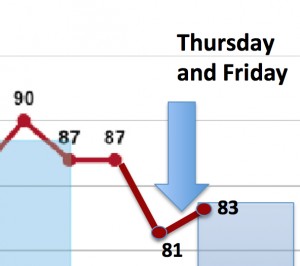 State officials and industry PR types thought they'd caught a break last summer when two things produced a much lower annual smog average, called a "Design Value."
State officials and industry PR types thought they'd caught a break last summer when two things produced a much lower annual smog average, called a "Design Value."
Since it's a three-year rolling average of smog numbers, past years roll off as new ones come on. Smog numbers from 2011 that had been so high they'd sent the average soaring, were finally rolling off and wouldn't be included in the average.
Second, unusually cooler temperatures and rain kept a new round of numbers lower. Combined, these factors resulted in a significant decrease in the smog average for 2014.
But in 2015, a more typical summer, or at least August, is bringing the average back up (Over 60% of the 100 highest recorded levels of smog this summer occurred in the last 30 days). Smog levels are higher across the board this year than last. There are more monitors recording more "exceedences" of the national smog standard. Leading them all is the Denton monitor, which saw ozone levels rise on Thursday and then skyrocket on Friday. The numbers were so high on both days they moved the needle of the annual smog average, the DFW Design Value, up from 81 to 82 parts per billion (ppb) on Thursday and up to 83 ppb on Friday. The standard is 75 ppb.
Even though Houston has recorded higher smog numbers than DFW this year, 2014's lower smog numbers was even more anomalous for that city than for North Texas. Last year's much lower numbers in the Bayou City are canceling out this year's much higher numbers. So that in 2015, DFW's Denton monitor's annual average of 83 ppb is the highest in the State of Texas.
And that means that according to the official accounting of the Clean Air Act, DFW has dirtier air than Houston. And not for the first time.
It also means we're rolling backwards in terms of air quality progress. With at least a whole month of "ozone season" to go, DFW's smog average is now only a little lower than it was in 2009. It would only take one or two more bad days to raise the average again.
This is the second time in four years that DFW's smog average has increased during the implementation of a state clean air plan for the area. Neither plan required new controls on large industrial polluters significantly contributing to the problem, like the gas industry, East Texas coal plants, and Midlothian cement kilns. There may be some connection there.
Given the state's stellar two decade-old track record of never meeting a clean air plan deadline, its latest plan was always likely to fail. But a federal court roll back of the deadline to get to the 75 ppb standard at all DFW monitors, from 2018 to 2017, plus these new 2015 smog numbers, make it DOA in the real world.
However, in the regulatory world governing these things officially, the plan is still being reviewed by the EPA and, believe it or not, could get approved if citizens don't make a big stink.
That's why you need to sign our Change.org petition to EPA to reject the state's plan and send an email to EPA officials requesting they write a new clean air plan instead of the state of Texas.
Many clean air advocates cautioned that 2014 should be seen as a outlier, and this summer is justifying that caution. If the experts are right, climate change will mean future summers will be more like 2011 than 2014. We've got to have a more realistic approach to the goal of safe and legal air. The State of Texas will not provide that. EPA can.



